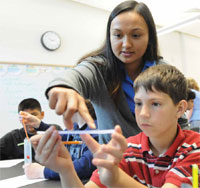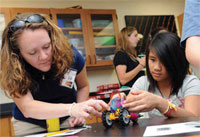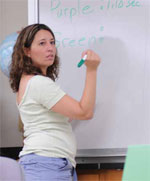No Science Teacher Left Behind
May 3, 2010
If you think the drop-out rate for high school students is high, you should see the drop-out rate for science teachers. Uncertified science teachers in the public schools leave the profession at a rate of about 66 percent, leading to an ongoing national shortage and poor student test scores. Researchers and educators at Mason are working to ensure the success of these teachers and their students.

SUNRISE Fellow Manisha Shrestha,
MS Biochemistry '09, teaches fifth
graders about bioluminescence
using glow sticks
On one June morning, graduate students from the College of Education and Human Development could be found on the sidewalk in front of Fenwick Library racing cars with elementary school students. What looked like all fun and games was actually a scientific investigation into whether model cars went faster on battery or solar power. Later, students designed experiments to determine the effects of various color filters on the power produced by a solar cell.
This isn't what you would expect of a summer camp, but science education expert Donna Sterling believes that such activities can make all the difference in science education for Virginia.
The solar-cell test was one of a series of experiments conducted by students at a camp coordinated by Mason's Center for Restructuring Education in Science and Technology (CREST) and held at the university this summer. Each year since 1997, CREST has offered two-week day camps with hands-on laboratory and field experience for youngsters.

Kelly Dumermuth (right) at Manassas
Park Elementary.
But the campers aren't the only ones learning. CREST camps are taught by graduate students in the education summer course Science Methods for the Elementary Classroom.
Shifting Paradigms

Donna Sterling and Wendy Frazier
Each year, Sterling, CREST director and one of the leading science educators in Virginia, challenges a lot of aspiring teachers, but she does it for good reason. "They want to teach science how they learned it," she says. Usually, this approach involves a PowerPoint presentation that provides all the answers.
"I tell them, ‘The information is great, the science is good (assuming it is), but that's not where we need to start with this age group,'" says Sterling. "The camp enables me to move them to a different setting." The future teachers have all the same equipment, materials, and academic standards, but they also have the freedom to try something new, something fun.
As part of their course work, the aspiring teachers develop the topic and curriculum for the camp. They then take turns teaching the components. All teaching is problem based and involves inquiry-based learning. For students in this year's CREST camp, the problem involved developing a model car that would complete an obstacle course in the shortest time.

SUNRISE Project director Rajesh
Ganesan meets weekly with the
fellows on the Mason campus.
Over the course of the camp, the campers and their student teachers looked at speed, power sources, terrains, weather conditions, and safety. Each experiment and discussion was a building block that brought the campers closer to designing the fastest, safest car.
"Research shows that, in the science classroom, connectivity is a problem," says Sterling, who has a background in chemistry and was a research scientist before coming to teaching. "New teachers tend to teach one thing after another. Instead they need to connect things and build up."
"We also try to teach science that is useful for life," says CREST associate director Wendy Frazier, who has directed past camps. "When students understand the meaning behind the science concept or the technology, they retain the information better and can apply it in a variety of ways."
This was second year that Mollianne Logerwell, PhD Science Education Leadership '09, taught the Science Methods course and codirected one of the camps, which was titled Motor Mania. She came to believe so strongly in the camp experience that she wrote her dissertation on the effects of teaching at the camp on preservice teachers.
"I worked on the research aspects of the camp and quickly saw what a beneficial program it was for teachers and students," says Logerwell. "It is such a rewarding experience to watch preservice teachers transform over such a short time."
Sterling and Frazier say it is a huge paradigm shift for the future teachers, but they are with them every step of the way. "We try to help them envision what science in the classroom can be, and we are there to support them as they try to implement [these practices]," says Sterling. "So they plan [the lessons] and try them out on real kids-and see what works."
The preservice teachers get immediate feedback throughout the experience. After a camp session, they meet with Sterling and the camp directors to talk about what went well and what needs adjusting before the campers return the next day.
"In the beginning, student teachers are nervous about teaching and uncertain of their science knowledge," says Logerwell. "By the end, however, they are full of enthusiasm and confident in their ability to teach science."
Scientists in the classroom

Fifth-grader Shannyea Wichard
at Manassas Park Elementary
concentrates on her experiment.
Mason also is participating in the National Science Foundation's Graduate Teaching Fellows in K-12 Education Program (PK-12), which provides funding to engage science, technology, engineering, and mathematics (STEM) students in teaching. Since its inception in 1999, the NSF program has funded more than 200 projects at more than 140 universities throughout the United States and Puerto Rico. Mason is currently the only university in Virginia participating.
The Schools, University 'N Resources in Science and Engineering (SUNRISE) Project, as the NSF program is called at Mason, places eight fellows in elementary and middle schools in Alexandria, Manassas Park, and Fairfax County each school year. Fellows, who are all Mason graduate students in STEM fields, spend 10 hours a week in the classroom and work closely with the resident teacher to provide hands-on experiments that not only adhere to the Virginia Standards of Learning, but also enhance them.

Student teacher Penny Toro with CREST
camper Chanida Lerdritsomboon
during a lesson on weight and
aerodynamics.
The project is a win-win situation for the university and the public schools, according to Rajesh Ganesan, who serves as principal investigator on the $3 million, five-year grant.
"We want the fellows to serve as role models in the classroom and excite those students about math and science," says Ganesan, an assistant professor in systems engineering and operations research in the Volgenau School of Information Technology and Engineering. "But we are also working to create a group of scientists and engineers who not only are competent in research, but also are capable of communicating their knowledge to a wide variety of audiences. [The fellows] have the content knowledge but not the pedagogical skills."
Prior to entering the classroom, the fellows receive training from Sterling.
In addition to having access to the CREST director and attending weekly meetings as a group, the fellows also receive a critique of their teaching methods by the teachers with whom they are partnered in the public schools. At the same time, fellows assess the units they teach with preand post-testing. So in exchange for assistance with their teaching skills, such as classroom management, the fellows help the resident teachers expand their content knowledge. Sterling is one of the senior personnel on this project.

A car designed to test the
relationship between
aerodynamics and speed.
Ganesan is the veteran of the SUNRISE Project. Prior to joining Mason, he was involved with the program in the Tampa, Florida, school system while a PhD candidate at the University of South Florida. Ganesan sees building the workforce of the future as one of the SUNRISE Project's benefits.
Another benefit is providing additional resources to the public school systems that need them most. "Every school is so different," he says. "Some schools have many more English learners. That affects how things are taught and how long some lessons take."
Ganesan plans to continue the project beyond its fiveyear NSF commitment and is already working to find future funding. He also wants to make the inquiry-based curriculum materials created as a result of the fellows' work available to other teachers and school systems.
Some of the other experiments and learning units taught by the fellows have included observing, recording, and analyzing weather data; looking at infrared properties and how they are used in imaging; and investigating how differences in ocean salinity affect density. Ganesan has also encouraged the fellows to incorporate their research interests into teaching.
"The students have been excited about having an actual scientist in the classroom," says Kelly Beatty, who teaches science at Manassas Park Middle School and is partnered with microbiology PhD student Meghan West Durham- Colleran. "Theoretically, [the strategy] seems to be working. During the labs, my students are actively engaged, and test scores on the quarter exams have risen."
A Wealth of Knowledge
Another project funded by the NSF is the New Science Teachers' Support Network. Through this network, Sterling and her colleagues were able to identify the forms of support that were most vital to a new science teacher's success.

Student teacher Rebecca Cole
walks campers through a lesson
"Teachers have a daunting task. They must be instructional leaders, curriculum and assessment experts, special needs advisors, cheerleaders, educational visionaries, and change agents," says Sterling.
The network has chronicled the experiences of uncertified teachers in three Virginia school districts to determine how the new teachers' needs were addressed. Uncertified teachers are those not formally qualified to teach science but as close as the school system could find with the current shortage. New teachers can receive provisional status, which gives them three years to become certified.
"What [the school administration] tends to do is find someone with a background in science but no training in education," says Sterling. "They can justify that this person knows the content, and that's a step in the right direction."
Although most new teachers are assigned a mentor from within their school, Sterling and her researchers found that providing them with a coach worked best in most cases. The coach was a retired science teacher, sometimes from that school, who served as an in-class mentor and was able to help the new teacher perfect his or her teaching and enhance student learning.
"Retired master science teachers are an excellent source of support because many have the skills, knowledge, and time to work with new teachers," says Frazier. "Not only can retirees observe classroom teaching and provide support throughout the school day, they can identify when a teacher is being treated poorly and serve as an advocate."
Free from the constraints of teaching their own students, retired science teachers are able to help new teachers plan effective lessons, identify strategies and organizational ideas for laboratory activities, and model effective teaching techniques during a lesson.
Another strategy that increased the new teachers' chances for success was the opportunity to take a science methods course such as those offered through the college.

Student teacher Tracy Pintard
discusses model car design
with camper Grant Sisson.
"As school districts continue to hire uncertified science teachers, there is clearly a need for a more thorough understanding of how effective support programs targeting this special population of teachers function, so that replication is possible," says Frazier.
Since she joined the university in 1993, Sterling estimates that she has worked on more than 35 grants to help science teachers and teaching in Virginia, and almost all of those have been collaborations with funding coming from a variety of resources, including the U.S. Department of Education.
Sterling and Frazier were recently recognized with a Partner in Education Award from the Alexandria City Public Schools. The award was presented for teacher professional development in two elementary schools and in appreciation for outstanding service and extraordinary commitment to all students of the Alexandria City Public Schools.
Jennifer Edgerly contributed to this story.
